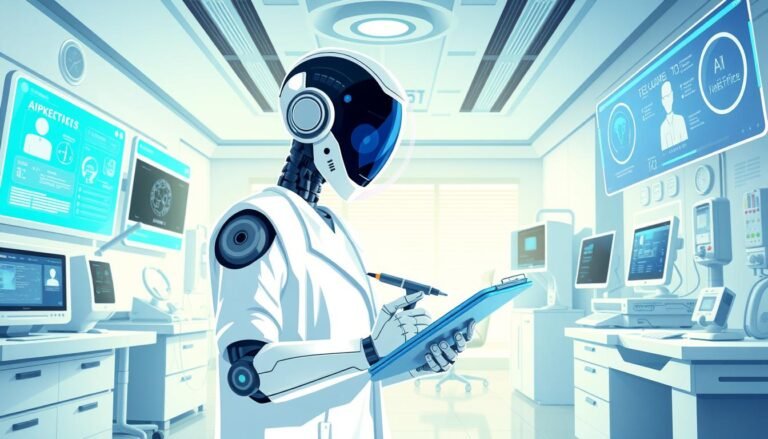Best AI Translation
Have you ever thought about AI connecting languages? AI translation tools are changing how we talk across borders. Lokalise AI, ChatGPT, and DeepL are leading this change, giving us quick and accurate translations.
AI translation uses machine learning and neural networks to understand language. These models are making automated translation faster and cheaper than before.
The shift from old systems to neural machine translation is amazing. Now, AI can understand context, making translations almost as good as humans. This change is making global communication easier for businesses and people.
Key Takeaways
- AI translation tools offer rapid, cost-effective language solutions
- Neural machine translation significantly improves accuracy and fluency
- Multilingual models can handle numerous languages simultaneously
- AI translation is reshaping global business communication
- Continuous learning allows AI systems to improve over time
The Evolution of AI Translation
AI translation has grown a lot since the 1960s. It has moved from simple rules to advanced AI engines. This change has made talking across languages easier than ever.
From Rule-Based to Neural Machine Translation
At first, translation tools followed strict rules. They found it hard to understand the fine details. The 1990s brought a new approach with statistical models.
The big leap was in 2017 with neural machine translation. This method uses deep learning to get the language right. It makes translations sound more natural and accurate.
The Role of Natural Language Processing
Natural language processing (NLP) is key in today’s translation. It helps AI understand the deeper meaning of words. This way, translations feel more like they were written by a person.
How AI Improves Translation Accuracy
AI translation engines get better with time by learning from lots of data. They can handle specific terms and keep a memory of translations. This means less need for humans to fix mistakes.
AI is great for translating lots of text fast and cheap. It’s perfect for companies that work all over the world.
Understanding AI Translation Technologies
AI translation technologies have changed how we talk across languages. They use smart methods to translate text quickly and accurately. Let’s look at what makes AI translation work.
Machine Learning in Translation
Machine learning is key to AI translation. It lets systems learn about language by looking at lots of bilingual data. Statistical Machine Translation (SMT) and Neural Machine Translation (NMT) are advanced methods that use deep learning for better results.
Neural Networks and Deep Learning
Neural networks, especially Recurrent Neural Networks (RNNs), are great at understanding word and phrase connections. This makes translations sound more natural and smooth. The transformer architecture is a big step forward in Natural Language Processing. It handles long sequences well, leading to better translations.
Contextual Understanding in AI Translation
Modern Language Models like BERT and GPT have greatly improved AI translation. They grasp language patterns and subtleties, leading to more precise translations. Attention mechanisms help the models focus on the right parts of the input, ensuring cultural and colloquial expressions are translated right.
As AI translation gets better, it can handle more complex tasks. From Google Translate’s over 100 languages to DeepL’s 32 languages, these tools are making talking across the world easier than ever.
Best AI Translation Tools in the Market
AI translation has changed how we talk to each other in different languages. Let’s look at some top tools that are leading the way.
Google Translate is a standout tool. It supports over 100 languages and lets you have real-time conversations. It has a 4.6/5 rating from over 400 reviews on G2, making it a favorite for fast translations.
DeepL Translator is known for its accuracy, especially with European languages. It covers 31 languages and has a 4.8/5 rating on Capterra from over 130 reviews. DeepL also offers top security, meeting ISO 27001 and GDPR standards.
Lokalise AI is great for businesses. It works with over 55 popular tools and offers precise AI translations. This makes it perfect for companies wanting to grow globally.
| Tool | Languages Supported | G2 Rating | Capterra Rating |
|---|---|---|---|
| Google Translate | 100+ | 4.6/5 | 4.6/5 |
| DeepL Translator | 31 | 4.6/5 | 4.8/5 |
| Quillbot Translator | 45 | 4.4/5 | 4.6/5 |
| Copy.ai Translator | Not specified | 4.7/5 | 4.5/5 |
These AI tools are changing how we talk across languages. With AI, businesses can cut down manual translation by up to 90%. This makes it easier to connect with people worldwide.
Comparing AI Translation to Human Translation
The debate between AI and Human Translation is growing as technology gets better. Both have their own strengths in making translations accurate and efficient.
Speed and Efficiency
AI translation tools are incredibly fast. They can translate a whole novel in less than two minutes. Human translators, though skilled, work much slower because of the complexity of their job.
Cost-Effectiveness
AI translation is often cheaper. These tools are cost-effective for individuals and small businesses. Human translation services, done by experts, cost more.
Accuracy and Nuance
Human translators are better at getting the translation right. They understand cultural meanings, slang, and idioms well. AI tools, though getting better, still find it hard to grasp context, cultural subtleties, and unclear sentences.
| Aspect | AI Translation | Human Translation |
|---|---|---|
| Speed | Novel in 2 minutes | Slower, time-intensive |
| Cost | More affordable | Higher cost |
| Cultural Nuance | Struggles with context | Excels in cultural understanding |
| Accuracy | Improving, needs proofreading | High accuracy, especially for complex content |
Using a mix of AI’s speed and human expertise often gives the best results. This approach balances efficiency and accuracy in translation projects.
AI Translation for Business and Enterprise
AI translation tools are changing how businesses talk to the world. They can quickly translate lots of text. This helps with serving customers in many languages and marketing globally.
These tools are made for businesses. They work with content systems and let you create your own dictionaries.
Tools like Google Translate and Microsoft Translator support over 100 languages. They’re favorites for big companies. DeepL, known for its natural translations, covers 31 languages and is becoming more popular in work settings.
These AI tools are great for companies that need fast results and can’t spend a lot of money.
| AI Translation Tool | Languages Supported | Key Feature |
|---|---|---|
| Google Translate | 133 | Free text, voice, image translation |
| Microsoft Translator | 100+ | Customizable neural translation systems |
| DeepL | 31+ | Human-like translations |
Companies using AI for translation get to market faster, up to 50%. WishTrip, for example, saw a 30% boost in lead conversion after using AI in 14 new languages in a year. This shows how AI translation can really help businesses talk to the world.
Multilingual Models and Language Support
Multilingual AI models have changed how we translate languages. They can handle many languages, from common ones to rare ones. This is a big step forward in breaking down language barriers worldwide.
Coverage of Major World Languages
Today’s AI translation tools can handle many languages. For example, Facebook AI’s M2M-100 model can translate between 100 languages. It even beats systems focused on English by 10 points in quality.
The size of these models is huge. M2M-100 is trained on 2,200 language directions, much more than before. It does about 20 billion translations every day on Facebook News Feed.
Handling Rare and Low-Resource Languages
While big languages get a lot of help, rare ones face big challenges. AI models find it hard to work with these languages because of less data. But, people are working hard to make translation better for these languages.
| Model Feature | M2M-100 | Previous Models |
|---|---|---|
| Language Directions | 2,200 | 220 |
| Parameters | 15 billion | 1.2 billion |
| BLEU Score Improvement | 1.7 (average) | Baseline |
New ideas like back-translation and dense scaling have really helped. They’ve made translations better for all languages. This brings us closer to making AI translation work for all languages, big and small.
Challenges and Limitations of AI Translation
AI translation has made big steps forward, but it still has big hurdles. One major challenge is catching cultural nuances. Machines are fast, but they struggle with idioms, slang, and cultural references that need human insight.
Getting the translation right is a big worry. AI models can miss the context and subtleties, missing emotional tones or cultural sensitivities. This is especially true in fields like law or medicine where accuracy is crucial. Despite the growing global AI market, these issues remain.
AI struggles with rare languages because of limited training data. Tools like Google Translate and Microsoft Translator need vast datasets to get better. For languages with less data, the quality of translations can drop.
Dependence on data also brings up concerns about biases in AI translations. If the training data has biases, these can show up in the translations. This highlights the need for diverse, high-quality datasets to ensure fair and accurate translations for all languages and cultures.
Integrating AI Translation in Content Management Systems
AI-powered localization is changing how businesses manage multilingual content. It makes creating and maintaining websites in multiple languages easier.
Website Localization with AI
AI translation technologies make website localization faster and more cost-effective. They can translate large volumes of content in minutes, not days. This speed is crucial in today’s fast-paced digital market.
AI translation also maintains consistent terminology across all content. This ensures the brand voice in different markets.
Neural Machine Translation (NMT) produces more accurate translations than older methods. It improves continuously as it processes more data. Some AI translation tools can even be customized for specific industries or companies, further enhancing accuracy.
API Integration for Seamless Translation
Translation APIs allow for real-time translation of dynamic content. This supports multilingual websites and applications, enhancing global reach. API integration facilitates efficient management of translations across various content types, from web pages to marketing materials.
| Translation Tool | Languages Supported | Character Limit (Free Version) |
|---|---|---|
| Google Translate | 133 | 5,000 |
| Bing Microsoft Translator | 128 | Not specified |
| DeepL | 31 | 1,500 |
By integrating AI translation into content management systems, businesses can significantly reduce translation costs. Machine translation services can be as low as $0.000010 per character, compared to $0.15 to $1.00 per word for human translation. This cost-effectiveness, combined with speed and accuracy, makes AI translation an invaluable tool for global businesses.
The Future of AI Translation
AI Translation Trends are changing how we talk across languages fast. Advanced Translation Models are set to change communication. They will make translations more accurate and aware of context.
Neural Machine Translation (NMT) systems like Google Translate and DeepL Translator lead this change. They are getting better, with some translations reaching up to 90% accuracy. This makes AI translations useful for daily chats and big content projects.
The Future of Language Technology also means more inclusive systems. Current models focus on languages like English and Spanish. But, there’s a push to improve translations for languages like Bengali and Swahili. This will help connect people worldwide.
Real-time translation is another exciting area. Streaming services are already using AI for subtitles. This makes shows and movies available to more people. As these tools get better, we’ll see instant translations everywhere.
But, human touch is still important. The best future mix is AI speed with human review for accuracy and cultural understanding. This is key for important talks and personal interactions.
Working together, researchers, linguists, and AI experts will create better translation models. These models will not just translate words. They will also understand the true meaning of communication across languages and cultures.
Ethical Considerations in AI Translation
AI tools like ChatGPT and DeepL are changing the language world. They raise big ethical questions. Balancing tech progress with responsible use is key.
The fast growth of these tools brings both chances and problems. It’s a big challenge for everyone involved.
Data Privacy and Security
Data privacy is a big deal with AI systems. They handle a lot of data every day. Keeping sensitive info safe is very important.
YouTube now asks creators to say if their content is AI-made. This shows we need to be open about AI use. Users must make sure their data is safe when using AI translation services.
Cultural Sensitivity in Automated Translation
It’s important to be culturally sensitive in AI translation. AI systems can’t fully understand human nuances yet. This can lead to misunderstandings or offense, especially in languages with less data.
To tackle these issues, we need to work together. Human translators can help AI by adding their expertise. By being open, fair, and improving based on feedback, we can make AI translation more ethical.
Source Links
- 14 Best AI Translation Tools & Online Translators to Use Right Now – TranslatePress
- 9 AI translation tools you need to try – Lokalise Blog
- The Evolution of AI Translation: The Future of Translation | Wolfestone Translation
- How AI Translation Evolved and What’s Next
- AI Translation: The Future of Language Learning
- The 5 Best AI Translation Tools
- AI Translation | Beginner Guide | Rapid Translate
- 10 Best AI Translation Tools for Accurate Translations in 2024
- The top 10 AI translation tools for business growth in 2024
- Top 10 AI Translation Tools for Global Communication | DigitalOcean
- Council Post: Comparing And Contrasting AI And Human Translation
- Machine vs. Human Translation: Who Wins? – Localize Articles
- Best AI-based Translation Tools in 2024 and How to Use Them
- Top AI Translation Tools: Your Key to Effortless Translation
- What Are the Best AI Translation Tools to Use in 2024?
- Introducing the First AI Model That Translates 100 Languages Without Relying on English | Meta
- Beyond Translation: Localize your AI NPC experiences with our Multilingual Support feature
- Language Translation Using AI: Here Are The Benefits and Limitations | Nymbl Blog
- Machine translation (MT) VS generative AI for translation: Pros and Cons – Lokalise Blog
- The power of AI to automate translation workflows – Acclaro
- Best AI translation software: Explore these 9 solutions | Gridly
- 9 Best AI Translation Software (That You’ll Actually Use) | Copy.ai
- Artificial Intelligence and Language Translation in Scientific Publishing – Science Editor
- AI Translation: The role of AI in the future of translation
- The responsible guide to using AI translation – AJT
- No title found
- AI Translation Ethics: Balancing Innovation and Integrity







